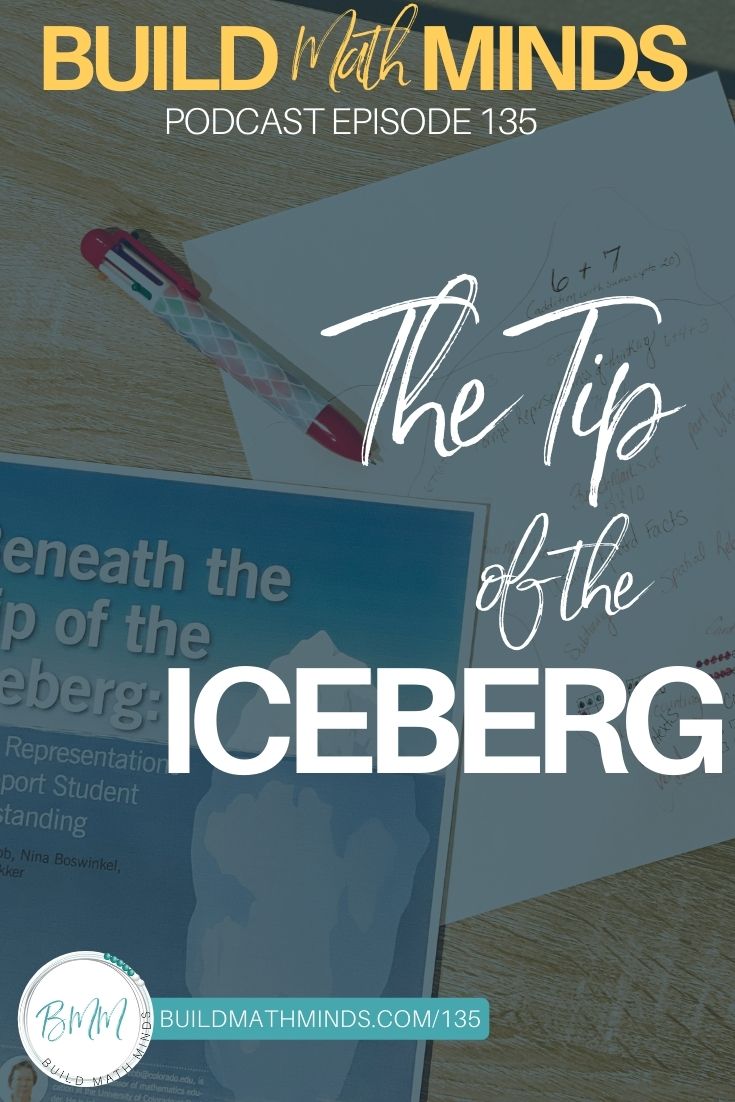Resources mentioned in this episode:
Video trainings at: The Recovering Traditionalist
Welcome fellow Recovering Traditionalists to Episode 135. Today we are looking at The Tip of The Iceberg.
In today’s podcast I’m doing something I’ve never done before: I’m sharing an article that was written about middle school math. Now please don’t let this scare you off, we aren’t diving into middle school math content. The ideas in this article really relate to all grade levels, it’s just they use examples that show middle school math topics.
This article presents a visual image that once I saw it, it has played a huge role in how I think about building our understandings of mathematics. I think about it often when I’m thinking about student learning and so I thought it was high time I share it with all of you.
In 2008, the article Beneath The Tip of The Iceberg: Using Representations to Support Student Understanding by Webb, Boswinkel, and Dekker was published. On pages 111-112 they describe the visual of the iceberg:
“It consists of the tip of the iceberg and a much larger area underneath, called the floating capacity. The tip of the iceberg represents the targeted formal procedure or symbolic representation. The bulk of the iceberg that sits under the water is represented by a combination of informal, including context-bound, representations (e.g., time, coins, part of an apple, and so on), which transition to preformal strategies and models (e.g., fraction strips, a number line, and so on). This metaphor can be used across many different problems. In the case of operations with fractions, for example, even before students can meaningfully discuss various strategies, they need to have an understanding of what a fraction represents.
In general, the progressive formalization suggested by the different levels within the iceberg’s floating capacity implies that more formal representations build on less formal ones. However, this does not mean that as soon as a student has reached a formal understanding that he or she will never return to the use of preformal representations. Rather, a student should be able to revisit preformal representations, especially when new and unfamiliar contexts are encountered.”
This image of the iceberg isn’t just for the different representations that help support student understanding, it really does pertain to all of our learning.
Think of the standard “Fluently add and subtract within 20 using mental strategies,” that is just the tip of the iceberg….what are all the things underneath the surface that help a student be able to fluently add and subtract? Yes, having different representations is part of that ‘floating capacity’ but so are other mathematical ideas. Understanding counting and how counting relates to addition & subtraction is part of that floating capacity. Building students’ understanding of the Part-Whole concept is also a huge part of that floating capacity….and I could go on and on but that’s what my videos over at The Recovering Traditionalist are for, to dive deeper into concepts.
So for now, to end out this podcast episode, I just want to encourage you to think about the things underneath the surface that we don’t often think about when we say a kid is struggling to do something. If a student is struggling with their multiplication facts, that is the tip of the iceberg. What is underneath, down in the floating capacity, that they haven’t built yet? What kinds of representations that are down in that floating capacity might help them?
If you aren’t quite sure what might be inside that floating capacity, the article describes how they did a professional development activity where they had teachers construct an iceberg around a particular math concept. You can also check out the video trainings I have at TheRecoveringTraditionalist.com. In my trainings, I like to focus on the conceptual understanding, or floating capacity, of math topics and not just the tip of the iceberg procedures. On the right-hand side of that site, I have categories of popular math concepts or you can use the search function at the top of the page to search for trainings around a particular keyword.
I’ll link to that site as well as the Beneath The Tip of The Iceberg article over at buildmathminds.com/135
Until next week, keep Building Math Minds.
This episode is brought to you by the Build Math Minds professional development site. It’s an online site full of PD videos designed specifically for elementary teachers to help you build your math mind so you can build the math minds of your students. If you are interested in getting in-depth Math PD at Your Fingertips, become a member of Build Math Minds. Just go to buildmathminds.com/bmm and depending upon when you are listening to this, enrollment might be open or you can join the waitlist and get notified when it opens again.




